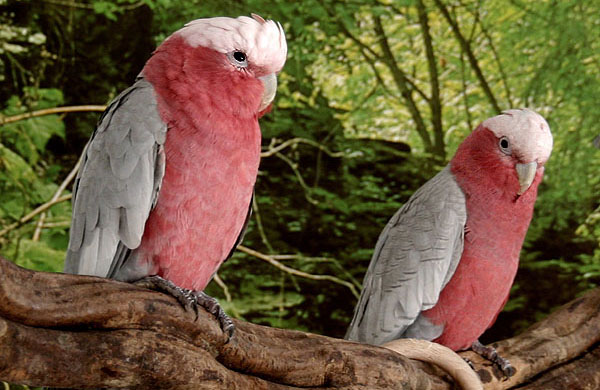Galah Cockatoo (Eolophus roseicapilla) - Wiki Galah
From Wikipedia, the free encyclopedia
[Photo] Pair of Galahs. Rosakakadu Thomas Schultz www.rosakakadu.com). Released into the public domain.
The Galah, Eolophus roseicapilla, (IPA: [g??'laː]) is one of the most common and widespread cockatoos. It occupies open country in almost all parts of mainland Australia.
Galahs have a pale to mid grey back, a pink face and chest, and a light pink crest. Sexes are similar, differing only in eye colour: the male has a brown iris, the female red. Typical birds are about 350mm long and weigh between 300 and 400 grams.
Systematics
The classification of the Galah was difficult. It was separated in the monotypic genus Eolophus, but the further relationships were not clear. There are obvious morphological similarities between the galah and the white cockatoos that make up the genus Cacatua and indeed the galah was initially described as Cacatua roseicapilla. Early DNA studies allied the galah with the cockatiel or placed it close to some Cacatua species of completely different appearance. In consequence, it was thought that the ancestors of the galah, the cockatiel and Major Mitchell's Cockatoo diverged from the main white cockatoo line at some stage prior to that group's main radiation; this was indeed correct except for the placement of the cockatiel. Ignorance of this fact, however, led to attempts to resolve the evolutionary history and prehistoric biogeography of the cockatoos, which ultimately proved fruitless because they were based on invalid assumptions to start with.
It fell to the study of Brown & Toft (1999) to compare the previously available data with their mitochondrial 12S rRNA sequence research and resolve the issue. Today, the galah is seen, along with Major Mitchell's Cockatoo, as an early divergence from the white cockatoo lineage which have not completely lost their ability to produce an overall pink (Major Mitchell's) or pink and grey (galah) body plumage, while already being light in colour and non-sexually dimorphic. The significance of these two (and other) characters shared by the Cacatuinae had previously been explained away in earlier studies by strict application of parsimony on misinterpreted data.
Aviary-bred crosses of galahs and Major Mitchell's Cockatoos have been bred in Sydney, with the tapered wings of the galah and the crest and colours of the Major Mitchell's, as well as its plaintive cry.
Three subspecies are usually recognised. The south-eastern form, E. r. albiceps, is clearly distinct from the paler-bodied Western Australian nominate subspecies, E. r. roseicapillus, although the extent and nature of the central hybrid zone remains undefined. Most pet birds outside Australia are the south-eastern form. The third form, E. r. kuhli, found right across the northern part of the continent, tends to be a little smaller and is distinguished from albiceps by differences in the shape and colour of the crest, although its status as a valid subspecies is uncertain.
Ecology
Galahs are found in all Australian states, and are absent only from the driest areas and the far north of Cape York Peninsula. They appear to have been self-introduced to Tasmania. They are common in some metropolitan areas, for example Perth and Melbourne, and common to abundant in open habitats which offer at least some scattered trees for shelter. The changes wrought by European settlement, a disaster for many species, have been highly beneficial for the galah because of the clearing of forests in fertile areas and the provision of stock watering points in arid zones.
Galahs are highly social and very long-lived: though they are sometimes kept as pets, this is not something to be undertaken lightly as they bond socially with their owners and may well outlive them, and like most cockatoos, are noisy and require a great deal of attention and care.
Like most other cockatoos, Galahs create strong life-long bonds with their partners.
Australian slang term
"Galah" is also derogatory Australian slang, synonymous with 'fool' or 'idiot'. Inquiries of Australian countrymen in the 1970s suggest that this is a misunderstanding. It seemed to be that the reference to a 'silly galah' is based on the sheer exuberance of the species and its willingness to indulge in play behaviour - galahs appear completely devoid of "dignified" or calm behaviour to the observer. Max [at Manly Vale WRL, 1977] held that galahs are very self-confident and have a great zest for life, and seem not in the least disturbed in anything they may care to do or be caught doing. It is very common to see them hanging by one leg from telephone or power lines in a rainstorm getting soaking wet and screeching with delight. There are many reports of them tobogganing down the corrugated roofs of outback buildings. A detailed, yet comedic description of the Australian slang term can be found in the standup comedy performance of Paul Hogan, titled Stand Up Hoges.
http://en.wikipedia.org/wiki/Galah
| The text in this page is based on the copyrighted Wikipedia article shown in above URL. It is used under the GNU Free Documentation License. You may redistribute it, verbatim or modified, providing that you comply with the terms of the GFDL. |
